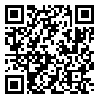Volume 22, Issue 5 (2022)
MCEJ 2022, 22(5): 21-36 |
Back to browse issues page
Download citation:
BibTeX | RIS | EndNote | Medlars | ProCite | Reference Manager | RefWorks
Send citation to:



BibTeX | RIS | EndNote | Medlars | ProCite | Reference Manager | RefWorks
Send citation to:
Jalalkamali R, Kamali Sarvestani P. Investigating the Situation of Urban Pathways Pavements Surface in Future Smart Cities Using Accelerometer Sensors and GPS Tools of Smartphones and GIS Application.. MCEJ 2022; 22 (5) :21-36
URL: http://mcej.modares.ac.ir/article-16-53902-en.html
URL: http://mcej.modares.ac.ir/article-16-53902-en.html
1- Assistant Professor, Faculty of EngineeringShahid Bahonar University of Kerman, Kerman, Iran. , r.jalalkamali@uk.ac.ir
2- Faculty of EngineeringShahid Bahonar University of Kerman, Kerman, Iran.
2- Faculty of EngineeringShahid Bahonar University of Kerman, Kerman, Iran.
Abstract: (1802 Views)
In smart cities, with using lots of new technologies, while creating appropriate facilities in routine urban life, infrastructure problems are investigated and the necessary measures are taken in a targeted and systematic manner to solve these problems. One of the most important technologies for managing infrastructure in smart cities is IT technology. GPS and smartphone sensors are other technologies that can be widely used in these cities. Streets, roads, and pavements are important infrastructures in any city and the future smart cities. Proper supervision, repair, and improvement of pavements, streets, and urban pathways are the main factor in reducing the cost of depreciation of vehicles and providing comfort and safety for citizens. On the other hand, if timely action is taken to restore and improve the pavement, huge costs of repair and reconstruction will be avoided, and this can significantly reduce the costs of urban management. The first step to achieving this goal is to identify the location of the roughness and distortion of the surface of the streets and urban pathways and the severity of these failures in the shortest possible time. In this paper, road surface roughnesses and failures have been studied using accelerometer sensors and GPS smartphone devices. Location and vertical acceleration data have been entered into GIS software and a quantitative index based on the values of vertical acceleration has been introduced to determine the quality of each section of urban road pavement. In this research, Androsensor software, which is a useful application for using smartphone sensors, has been used. This software is installed on two smartphones, Huawei, P30 Lite, and BlackBerry, Priv STV100. To collect the data, the smartphones were placed in a fixed position on the right and left sides of the car, on the dashboard. The collected data for analysis is transferred to the computer in Excel files. This research has been done in Kerman city and to collect data, different routes with specific failures have been selected. Data collection was performed in 81 pieces with a length of 500 meters and 24 pieces with a length of 200 meters (105 pieces, 45300 meters in total). By analyzing the vertical acceleration data and calculating some proposed indexes and comparing them, the best index has been selected. This index is classified into different ranges according to the field inspection of the pavement condition in the routes in this study, that each of which indicates the quality status of the pavement. Each of these intervals is introduced with a specific color, and by examining the index obtained in each route and the corresponding interval, the studied routes are marked with different colors on the map. Finally, it was found that the accelerometer sensors and GPS of smartphones can be used with low cost, high speed, and appropriate accuracy to check the surface of pavement of urban roads and grading the quality of the pavement. It also seems that in the smart cities of the future, which are based on IT technology, the use of user data, high accuracy in locating, and speed of action in prevention, the proposed method in this research can be used more favorably.
Article Type: Original Research |
Subject:
Roads and Transportation
Received: 2021/07/6 | Accepted: 2022/07/20 | Published: 2022/07/1
Received: 2021/07/6 | Accepted: 2022/07/20 | Published: 2022/07/1
Send email to the article author
| Rights and permissions | |
 |
This work is licensed under a Creative Commons Attribution-NonCommercial 4.0 International License. |









